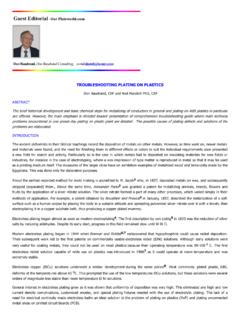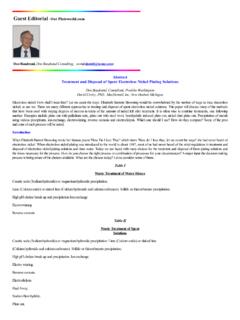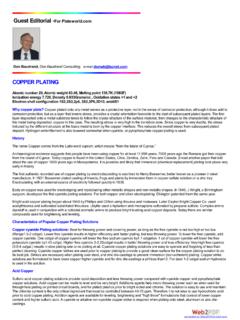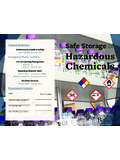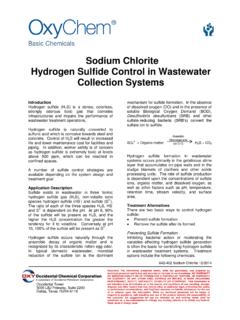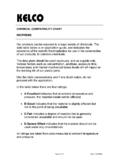Transcription of Conversion Coatings for Aluminum and Magnesium
1 Guest Editorial -For Don Baudrand, Don Baudrand Consulting, Conversion Coatings for Aluminum and Magnesium Introduction A Conversion coating refers to the chemical treatment of a metal surface where the metal is converted into a non-metallic form at the surface forming a film. Conversion Coatings have an important roll in the metal finishing industry because of their enhanced corrosion protecting and decorative appeal. Conversion Coatings have been around for many years. Coatings for iron and iron alloys such as black, and bluing; copper and brass, such as patina Verdi green and many others are well known.
2 Chromate coating was used for lead from 1872. Chromate solutions were used to treat Magnesium as early as 1924 Chromate conversions Coatings were developed for zinc, and cadmium, from, 1924 to Chromates for copper, silver, and Aluminum ,3,4 The first true chromate Conversion coating for Aluminum was introduced by Stricklen, Mater and Meth in 19525 Later improved chromate Conversion Coatings for Aluminum were Chromate Conversion Coatings for Aluminum became very important due to the corrosion protection, low electrical resistance, improved paint and adhesive bonding.
3 And self- healing properties that protect scratches by migrating into the scratch thus maintaining the Chromate Conversion Coatings also have low emissivity coefficient, less than that of anodize or painted surfaces. "This is important in preventing parts from heating up during exposure to infrared radiation." However for other applications, emissivity can be increased by applying a thicker Recently, non-chromium containing Conversion Coatings were introduced that are improvements over the early non-chrome processes and may rival chromate Coatings in some characteristics.
4 Chromate Conversion Coatings For Aluminum Chromate Conversion Coatings are formed when the chemicals in the chromating solution react with Aluminum , dissolving the Aluminum oxide and some metal causing a rise in pH at the solution to metal interface. The result is precipitation of complex hydrous oxides of Aluminum , chromium, and chromium chromate that form a gel on the surface. A portion of the hexavalent chromium is reduced by the metal surface to trivalent chromium that precipitates. Hexavalent chromium provides the greatest corrosion protection, but the trivalent chromium is necessary to form the proper coating.
5 Activators play an important part in forming the best coating. Materials that act as activators are chlorides, sulfate, formate, acetate, fluoride nitrate, phosphate sulfamate ions. These are used in small quantities. Most used in larger amounts will result in unsatisfactory Coatings . Chromate Conversion Coatings for Aluminum were developed during and following the Korean War. The acceptance of these Coatings was due to use as a low cost substitute for anodizing, and to the desirable properties. Good corrosion protection, the ability to seal over scratches, low electrical resistance, good grounding of Aluminum chassis, good paint adhesion and adhesive bonding characteristics, good spot-welding and arc welding made the use of chromate Conversion Coatings expand rapidly.
6 The chromate coating protects Aluminum from oxidizing and the chromate film acts as a flux to facilitate good spot and arc welding characteristics. Bare Aluminum oxidizes quickly and continues to build oxide thickness in most environments. Low emissivity of infrared (heat) is important for some applications to prevent excessive heating. Below is a comparison of chromated Aluminum with other surfaces. The scale is from 0 to1, where the most desirable is close to 0. Surface Finish Emissivity Bare Aluminum Yellow Chromate Anodize Most Painted surfaces Infrared radiation of Aluminum and related protective Coatings :8.
7 Changing the bath concentration, and treatment time can vary thickness or the chromate coating. The thin Coatings are clear. As thickness increases the color develops as a light iridescent yellow, golden, light brown and finally medium brown. Coatings can be made clear by leaching in hot water. Leaching removes the converted by develops as a light iridescent yellow, golden, light brown and finally medium brown. Coatings can be made clear by leaching in hot water. Leaching removes the soluble hexavalent chromium. Leaving the insoluble reaction products in tact.
8 These Coatings can be dyed various colors for identification or decorative purposes. It is difficult to maintain exact color matches for decorative applications, but it is used for special applications. Thin Coatings are used for low contact resistance (good electrical conductivity). Medium and darker (yellow) Coatings are best for maximum corrosion resistance. Brown Coatings may indicate over active processing solution or a very active surface, such as an alloy high in copper alloying constituent. Copper in the Aluminum alloy accelerates the chemical reaction causing a less satisfactory coating in terms of adhesion and corrosion protection.
9 Chromate Conversion Coatings protect Aluminum from oxidizing, thus these surfaces will have lower electrical resistance than un-protected Aluminum . Thinner Coatings have lower the contact resistance. Clear Coatings have the least resistance. Rougher surfaces will have lower contact resistance due to the ease of breaking through the coating by contact. Corrosion protection of Aluminum by chromate Conversion Coatings One of the main uses of chromate Conversion Coatings on Aluminum is to protect the Aluminum from corrosion. Military specifications requires withstanding 168.
10 Hours exposure to 5% neutral salt fog (ASTM B-117). In fact the protection can often exceed that requirement to over 500 hours. 1000 hours salt spray has been The added protection is dependent on several factors. Most important is the condition of the Aluminum surface. By condition I mean that the surface is smooth, free from pits or scratches, and the alloy is not too high in copper and/or other alloying constituents. Heat-treating copper containing alloys, such as 2024. and 6061 causes copper to migrate to the surface. The heat-treat process has fairly loose parameters specifications for heat-treating that can cause more, or less copper in the surface.
